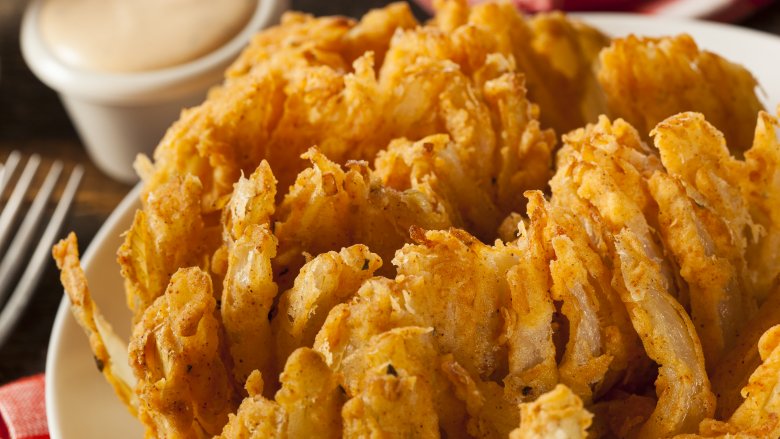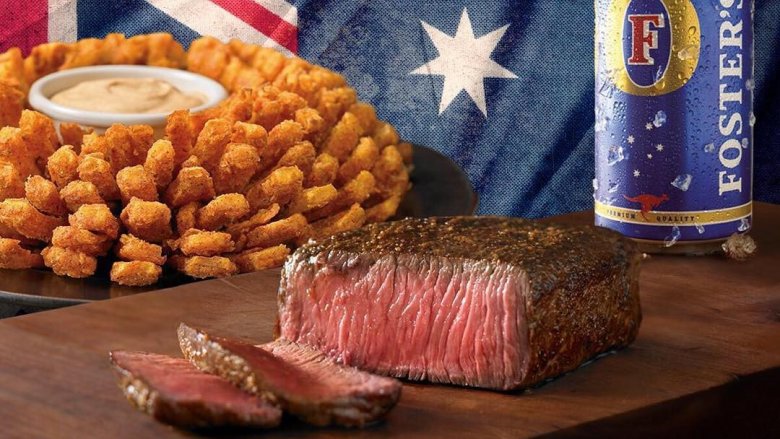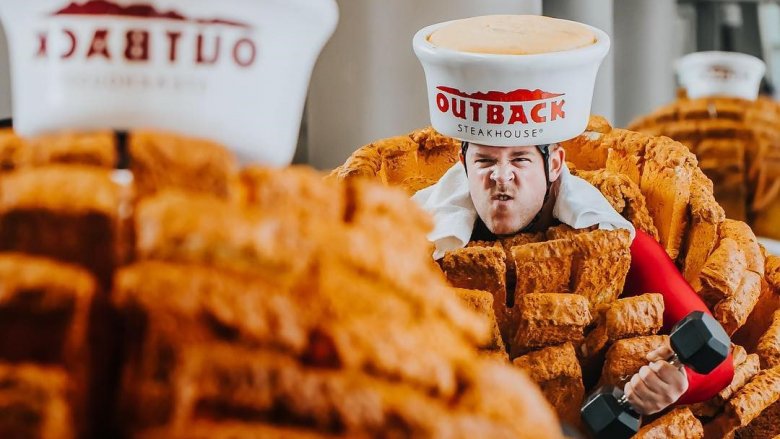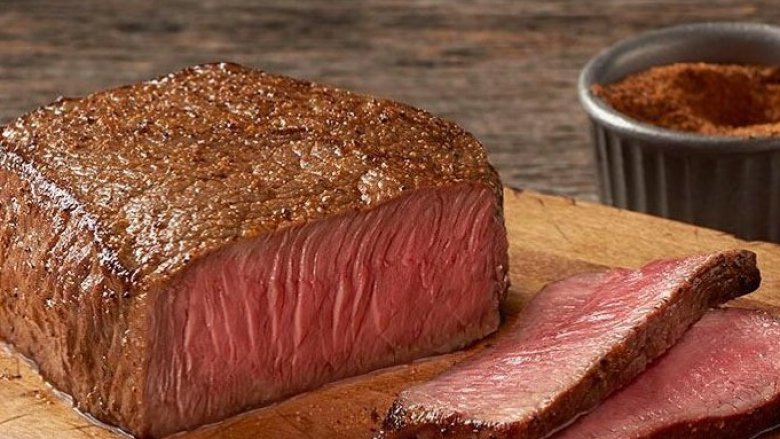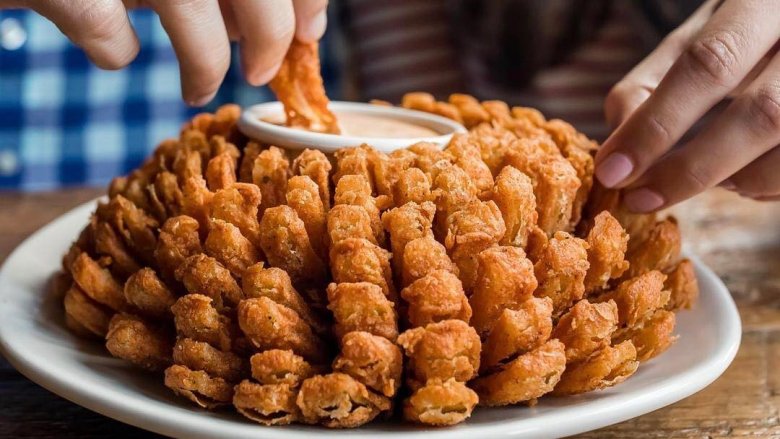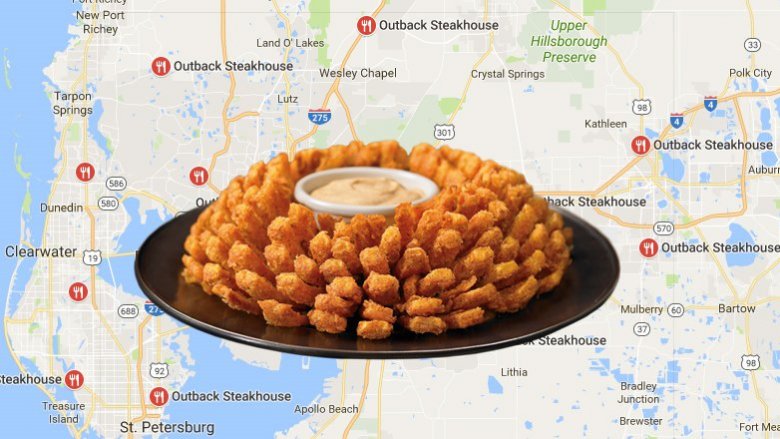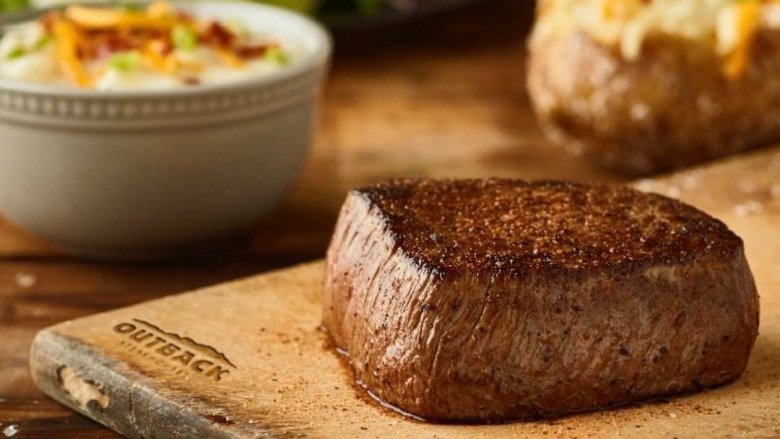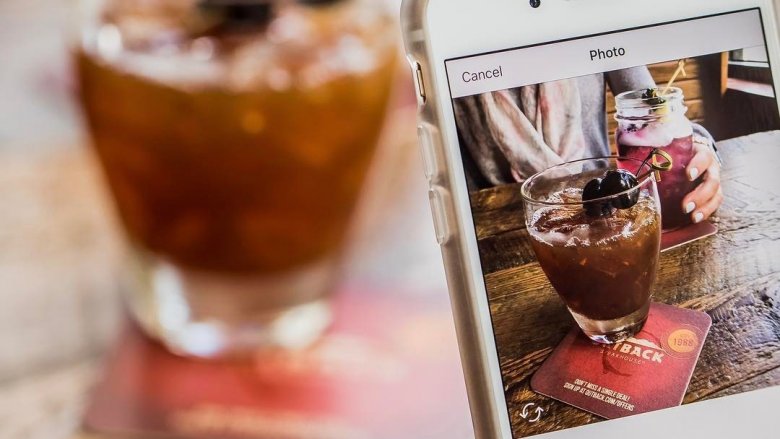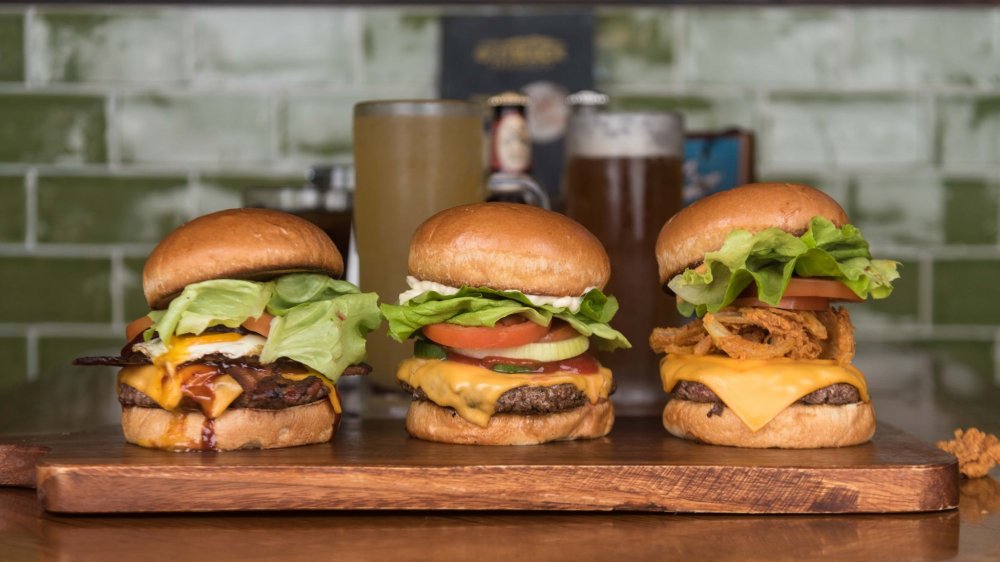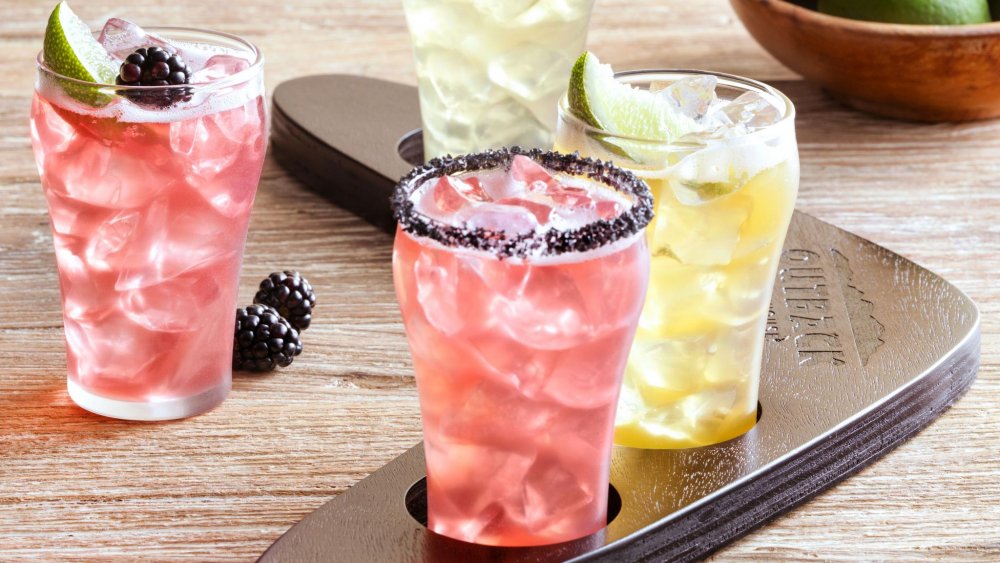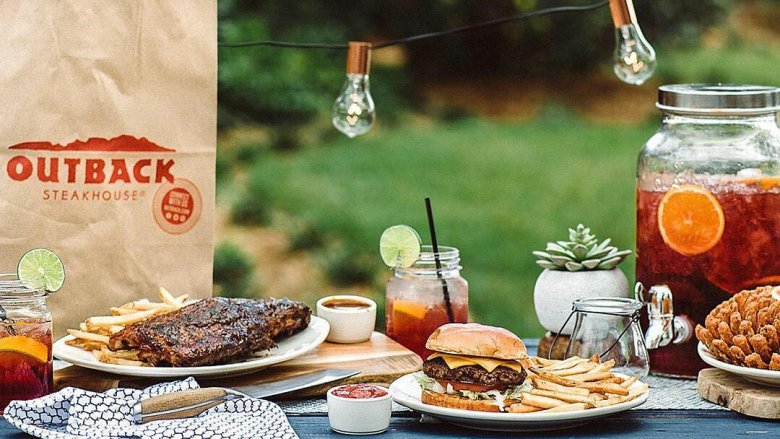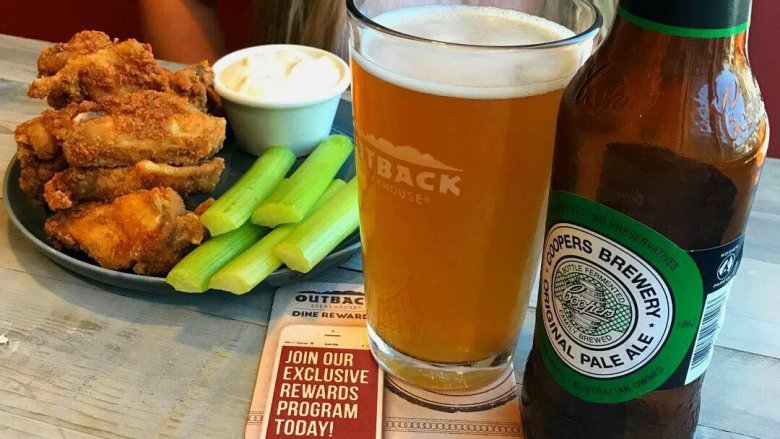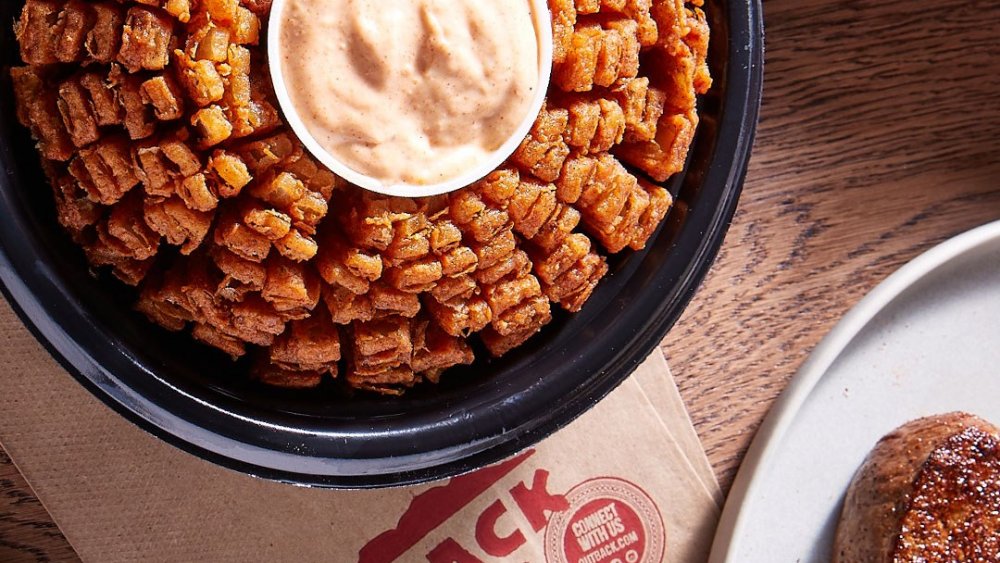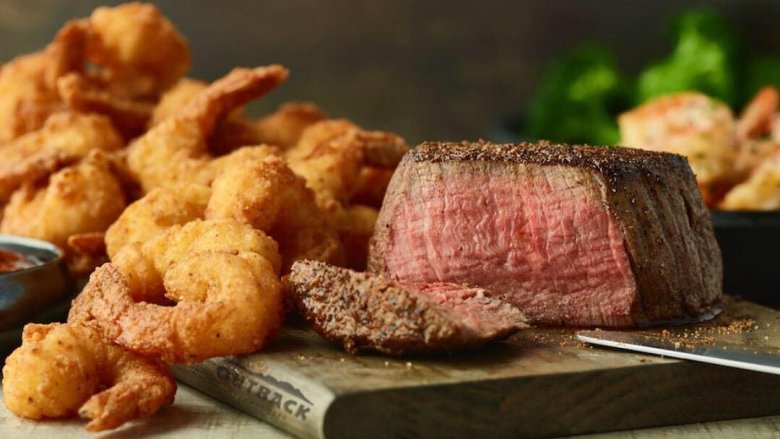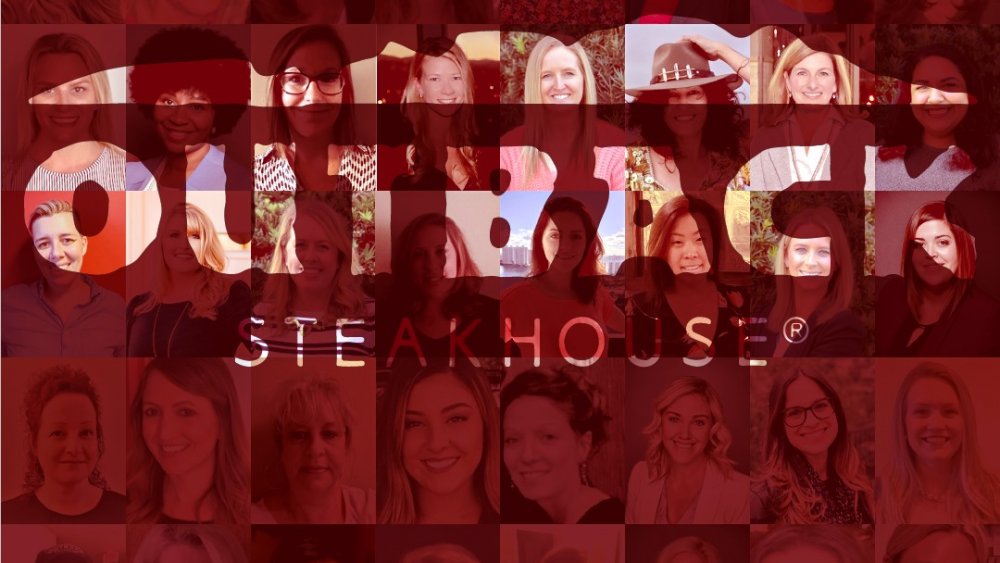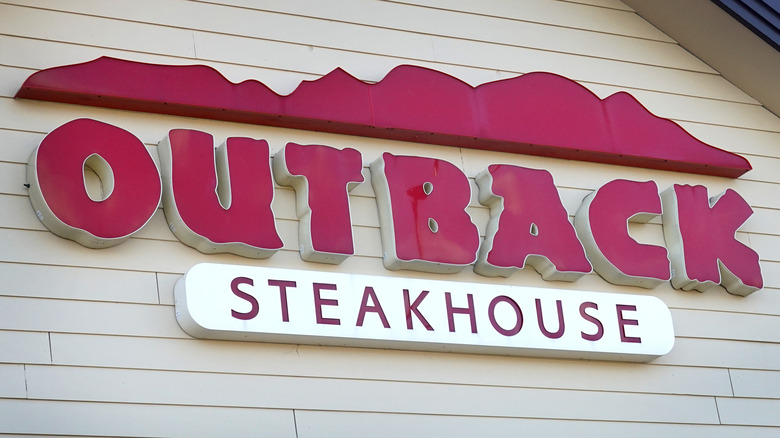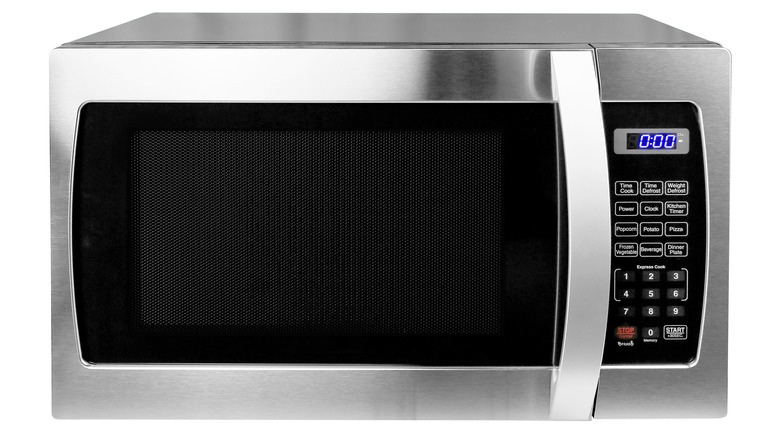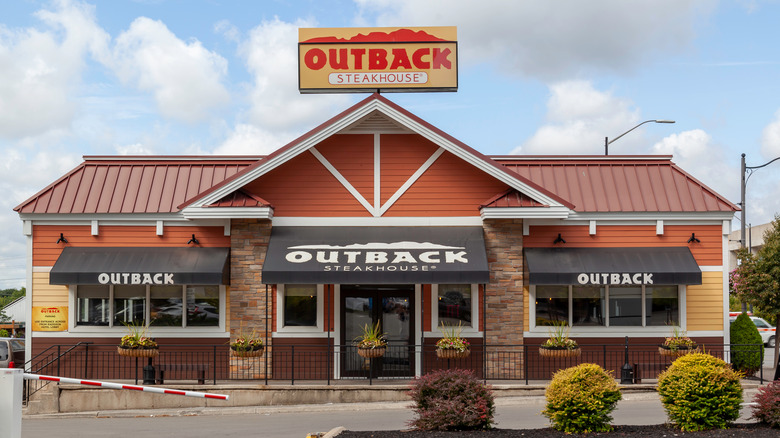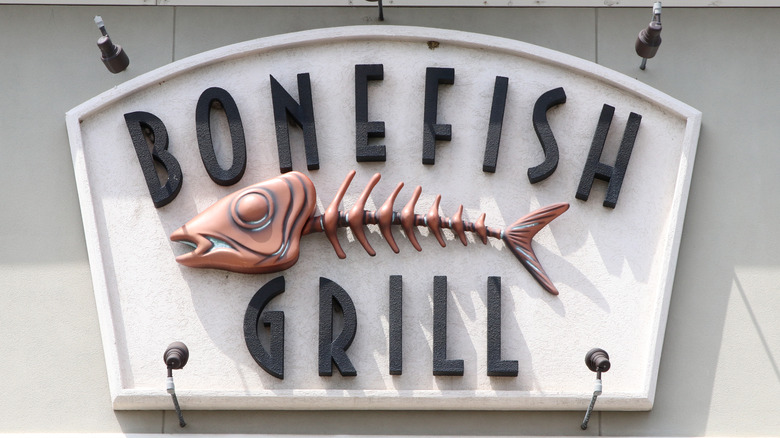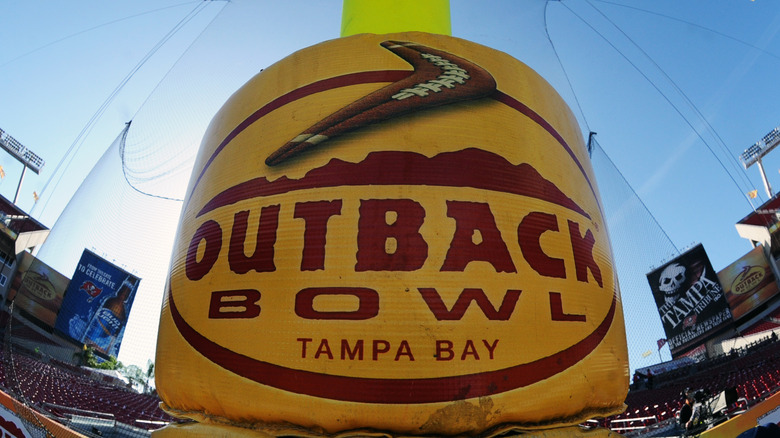The Untold Truth Of Outback Steakhouse
There was a time when anyone wanting a special night out would head to a place like Outback Steakhouse. Everyone in the family could find something on the menu they liked, whether it was chicken, a burger, or — of course — steak. But with the introduction of fast-casual dining and other new trends, it seems like more and more people are heading elsewhere, unfortunately for Outback.
But if you're looking for a place where you know what to expect, where coworkers and friends can get together after work for a few drinks and some appetizers, Outback might be your place. There's no denying that's largely because of the Bloomin' Onion, the flagship dish that's more popular than the steak ever was — even though it's in the brand's name. It's just the right amount of crunchy, and it's so bad for you that you'd better be sharing it. Let's talk about Bloomin' Onion secrets and some other things you didn't know about this chain.
The Outback Steakhouse founders had never been to Australia
Native Australian Besha Rodell reviewed Outback Steakhouse for LA Weekly in 2013 and confirmed it's pretty much nothing like what a native Australian might expect.
There's a good reason for that. Outback Steakhouse was founded by four Americans in 1988, and they were Americans who had never even been to Australia. They were inspired by "Crocodile Dundee" ... so let's put that into perspective. That's like a group of Australians founding an "authentic" American restaurant after watching "American Pie"... and no one wants that to ever happen.
When those founders were developing the idea, they specifically chose not to head off to the Land Down Under, because they wanted to cash in on the kitschy stereotypes Americans had about Australia. So instead, they scrounged things out of antique and junk stores that they thought sounded sort of Australian-ish — like sheep shears and bullhorns — and opened their first restaurant in a South Tampa strip mall. According to the Tampa Bay Times, the founders knew more about the business plans of restaurants like Bennigan's and Chili's, and that explains a lot.
Outback Steakhouse is not authentic Australian cuisine
Since the founders of Outback Steakhouse didn't actually want to be influenced by the real thing and instead made their restaurant a sort of stereotype of Australia, it's not surprising there's nothing about the food that's authentic, either.
Do you know what's not Australian, according to native Besha Rodell (via LA Weekly)? Shrimp on the barbie, along with Toowoomba pasta, and Bloomin' anything. Burgers, onions ... Not Australian. The Californian's Joe Truskot headed to Outback with an Australian friend, who ordered the Mixed Grill. She got a piece of chicken, baby back ribs, and coconut shrimp, which wasn't at all what she expected. When your order a Mixed Grill in Australia, you get something very different: sausage, liver, and bacon.
When one Quora user asked for native Australian opinions on Outback, one native answered, "Pizza Hut is more authentically Italian than Outback is Australian." That puts it all into perspective.
Outback Steakhouse seasons steaks with a shocking 17 spices
How do you season your steak? Chances are good it's pretty minimal, in order to let the taste of the meat be the main star. Seasonings, rubs, and spices should be the supporting cast, after all. Even Jamie Oliver recommends keeping it simple with salt, pepper, and a dash of garlic and rosemary, but Outback Steakhouses seasons its steaks with a secret recipe of 17 herbs and spices.
That's an insane number of ingredients, and seriously, when is the last time you made anything that took 17 ingredients? Cooks on the internet have, of course, tried their hand at deconstructing the seasoning recipe, and most have managed to make copycat recipes with only a fraction of the ingredients. A poster on Reddit guessed that it was a combination of salt, paprika, ground black pepper, onion powder, garlic powder, cayenne pepper, ground coriander, and turmeric. Outback advertises its rub as being pretty incredible stuff, but that raises the question of what, exactly, is in it? And more importantly, is it all necessary? When you order a steak, you'd like to get some steak flavor, too.
The Bloomin' Onion gadget used at Outback Steakhouse was once top secret
Let's be honest: If you're still going to Outback Steakhouse, you're probably going for the Bloomin' Onion. It's just the right amount of salty and crunchy, and how it was made used to be a major secret. There are 24 "petals" to each onion, and getting those perfect is the key to an even fry. That's intimidating and might make you think you shouldn't bother trying to make one at home, but you absolutely can.
You can even pick up the same gadget Outback uses, and while its specific tool is called the Nemco 55700 Easy Flowering Onion Cutter (via The Daily Meal), there are plenty of other versions out there that do the exact same thing.
And thanks to food hacker Todd Wilbur, you can get the taste right, too. In 2011, he infiltrated Outback's back offices (and kitchens) as a part of the CMT show "Top Secret Recipe." The Bloomin' Onion creators boasted about the 17 spices in the onion and 37 spices in the dipping sauce, and while Wilbur cracked the code, you'll have to buy access to his secrets.
Outback Steakhouse was accused of being Satanist
Social media is tricky sometimes, and restaurants need to deal with a ton of complaints, disgruntled customers, and keyboard warriors. Sometimes it's all in good fun, and in 2017 Outback found itself in the middle of a weird conspiracy theory that was retweeted over and over again. Proving it has a sense of humor, it played along.
The original tweet came from @eatmyaesthetics, a Twitter user who posted photographic "proof" that Outback Steakhouse locations in a few cities could be connected on a map to form a pentagram. The association was clear, and several keyboard warriors jumped to the conclusion that they must be supporting either witchcraft or Satanism. The Huffington Post says it was retweeted hundreds of thousands of times, and Outback Steakhouse responded with a cryptic image that showed its Bloomin' Onion hovering over a map Florida, and the comment, "If the Bloomin' Onion is evil then we don't want to be nice." Well played, Outback.
It was a struggle to open Outback Steakhouse, but success came fast
When Outback Steakhouse celebrated its 25-year anniversary in 2013, it had around 900 locations worldwide. The location the four founders chose to meet at was the original one, though, located at 3404 Henderson Boulevard in South Tampa.
They told the Tampa Bay Times that at the time they opened, there was nothing like it in the city. Casual dining wasn't as widespread as it would become, and to find a Chili's or similar restaurant, you'd have to go to the other side of the city.
When they opened there was a bit of time when they weren't sure it was going to work. Nights were so slow they had to have employees park in front of the restaurant to make it look like there were people there, and the founders poured a ton of elbow grease into getting it ready. That first location was in an old bar founder Trudy Cooper described as "... in very bad shape, and it smelled like alcohol." Yuck. Word spread fast, though, and other steakhouses started calling them to say they were taking business away.
Outback Steakhouse seems to lean to the Republican side
Outback Steakhouse might be struggling, but it has still donated an almost shocking amount of money to political campaigns — and that includes much, much more to one side in particular.
Eater reported that although companies can't directly donate to political parties, they can give money to company-sponsored political action committees, or PACs. These organizations allow shareholders and companies to pool resources and pass them on to political causes, and in the case of Outback, that's largely to Republicans.
Between 2011 and 2014, Outback's parent company Bloomin' Brands donated $1,091,030 to political causes, and 93% of that went to the Republican side. Per Eater, in 2016, Outback made roughly $350,200 in donations, with 88% of that going to the Republican party through the brand's PAC. Oddly, Bloomin' Brands CEO Elizabeth Smith was the only industry CEO to donate directly to a presidential campaign: She gave Hillary Clinton $5,400.
So, what kind of things are on Outback Steakhouse's menu ... in Australia?
So, let's say you're off in Australia and get a hankerin' for some steak. You could absolutely go to an Outback Steakhouse there ... but what will you find on the menu of this Australian-inspired restaurant when you're actually in Australia?
A quick peek at the website shows you won't find any claims of being authentically Australian, but the menu does look pretty tasty. You'll definitely be able to get your steak (from New York Strip to ribeyes, filets, and sirloin), and there's a ton of seafood, including crispy calamari and popcorn prawns.
Not a fan of seafood? You can also opt for some distinctly American choices like Cobb salad or Razorback ribs, and there are a handful of burger and pasta options, too. Finish it off with a dessert like the Chocolate Thunder or the New York-style cheesecake, and at the end of it all, you'll think you just had a very American meal.
Outback Steakhouse has had some issues with its alcohol service
One of the best things about going to Outback Steakhouse might be enjoying a delicious, frosty cocktail alongside your steak — you know, the kind that's too much work to make at home. But Outback has had its share of issues when it comes to its alcohol service, like one 2011 issue that's any parents' nightmare.
Per Business Insider, a 4-year-old girl was served a sample of a slushy made with vodka and peach schnapps. While the brand's official statement said that only the adults in the group were given the samples, workers had forgotten to mention they were alcoholic, and the adults actually gave the samples to the kids. Whatever the truth, that incident led to a change in policy and it's why you don't get those alcoholic free samples anymore.
Then, there was the tragedy Outback found themselves in the middle of in 2003. That's when Brett Walrath was out riding his bike, and was hit by Callie Long. Long was found to have a blood alcohol level of .13%, and according to KCBD News, the Outback Steakhouse that had served alcohol to her was named in the lawsuit.
The story doesn't have a happy ending. Walrath died of complications from his injuries in 2004, leaving behind his wife and son. In 2005, it was reported they had reached a confidential settlement with Outback Steakhouse.
Outback Steakhouse made some epic considerations for employees
In 2005, the Harvard Business Review ran a piece from Chris Sullivan, one of Outback Steakhouse's original founders. He said that since they had all started out at the very bottom of the restaurant business, they knew what it was like to work in each area and they wanted to make their restaurant different than most. Among their core tenets was this: "Tough on results but kind with people."
They ran several studies of their own restaurants and found the more satisfied their employees were, the more successful the location was. Customers liked coming back to the same staff, so they built locations to be comfortable for those employees.
Half of the footprint of each Outback is devoted to the kitchen, a ratio that's almost unheard of. The company spent extra money on extra ventilation for all that space, and Outback servers are only supposed to work three tables at a time — compared to most restaurants and where the standard is five or six tables. There are also not the layers and layers of management, middle management, and upper management most chains have. Outback had (at the time) six operations executives at its headquarters, 60 Joint Venture Partners that acted as regional managers, and store staff.
Why Outback Steakhouse hesitated at serving lunch
It wasn't until 2015 that Nation's Restaurant News announced that Outback would be serving lunch. It seems like a no-brainer, but Chris Sullivan told the Harvard Business Review that lunch was never a part of the plan.
He said it was all because of the employees. Restaurant managers forced to work through lunch and dinner are often wrangled into 80-hour work weeks, and when you're working that much it's tough to have any other kind of life. The company didn't want that for its employees, and it didn't want staff that was working two split shifts, either. By the time servers worked through a second meal shift in a single day they would be tired and more than ready to go home, and Outback's dinner-only plan was to help keep employees happy and, in turn, keep customers happy with the better service the restaurant was able to provide.
It also impacted the kitchen — prep cooks who needed to prep for a lunch would often prep for dinner at the same time, and by the time dinner rolled around, the food was less than fresh. Dinner-only was the way to go. After a year-long testing period, however, Outback decided the sales were worth it.
Outback Steakhouse's Bloomin' Onion is worse for you than you think
Sure, when most of us order a Bloomin' Onion it's for the whole table, but there's no denying that even splitting it with two people ... well, it's so good you start chatting and eating, and the next thing you know, it's gone, right?
Bad news, Bloomin' Onion fans: It's way worse for you than you think.
According to Calorie King, a regular Bloomin' Onion has 1950 calories and a whopping 155 grams of fat — which is more than twice your daily recommended limit. And how about sodium? That clocks in at 3840 mg — also, way more than you should have in a day. How about a little perspective? In order to work all that off, you'd have to swim for 163 minutes or walk for a little over nine hours.
That's terrible, but even worse is the Loaded Bloomin' Onion. That has 2,360 calories, which The Huffington Post notes is even more than many entrees from The Cheesecake Factory. Then there's offerings like the 3-point Bloomin' Onion, which MassLive called "weaponized fryer oil." That's pretty accurate: it has 3,080 calories. Is this something we need? Nah. It is something we want? Yes, and we're not ashamed to admit it.
Here's why Outback Steakhouse is disappearing
Let's zoom in on 2017, when Outback's parent company announced dozens and dozens of closures. The faux-Australian chain had been hard hit by a number of things, including an industry-wide shift from casual dining to fast-casual, and this — along with other factors — had led to losses in the millions. According to Business Insider, Bloomin' Brands was feeling the pinch across all their brands, which included not just Outback but its sister companies Carrabba's, Fleming's Steakhouse, and Bonefish Grill.
Outback is in a complicated position. Steakhouses on the whole are on their way out (and we take an in-depth look at their struggles here), so that's two strikes against Outback. Factor in the brand'sunhealthy flagship dish, the price tag of the food, and the fact that it's now a massive chain competing with much trendier independent restaurants, and the brand is heading down a rocky road. Then, add in the lawsuits, the accusations of racial insensitivity, and the bad press, and Outback's fate is up in the air. Want to know more about what's been going on? We have a whole article about why Outback is struggling. The closures haven't stopped in the last couple of years, either (via Statista).
Outback Steakhouse made a major sacrifice to help employees through the pandemic
The spring and summer of 2020 were filled with uncertainty, especially for restaurant workers. In April, the CEO of Outback Steakhouse's parent company, Bloomin' Brands, announced that he was forgoing his salary in order to help cover the salaries of frontline workers. David Deno's no-pay summer kicked off on April 6, and according to FSR Magazine, he said he would skip taking a salary for as long as needed.
And that's no small chunk of change: his base salary is $900,000 per year, with a possible bonus of 1.5 times his salary.
In addition, the members of Bloomin' Brands' board of directors also pitched in and announced they would forgo their salaries as well. According to Nation's Restaurant News, it made a huge difference: The company was able to retain many of its employees through the pandemic, and as soon as it was announced the restaurants could reopen, Outback was ready to go.
Outback has a simple motto
Every successful business needs a foundational principle. Outback is no different, and its slogan is decidedly simple: "No Rules, Just Right." You're probably familiar with the motto, as it has been a part of Outback's advertising for nearly as long as the chain has been in operation. The company submitted the phrase for trademark status in 1992 (via Justia).
According to Outback's website, the motto is meant to signify to customers that the restaurant is serious about quality, but not at the expense of fun. However, in an article penned for the Harvard Business Review, Outback founder Chris T. Sullivan explained that the phrase is also applicable to the chain's employees. There are no constrictive rules preventing employees in individual Outback locations from experimenting and coming up with new food and menu ideas. That doesn't mean every idea is accepted, but the freedom to play around helps Outback innovate. According to Sullivan, good ideas are accepted from every corner of the organization, not just from those in the executive suites who would traditionally be making the big decisions on their own.
Your food at Outback may have been prepared in the microwave
Outback Steakhouse is a casual restaurant, and the chain may take some shortcuts that high-end eateries wouldn't dare. According to employees, this includes cooking food in the microwave. In January 2022, one Outback staff member took to TikTok to show how the chain prepares its lobster tails. In the video, he cooks the lobster by putting it in a large tray with water, then placing the tray in the microwave. "[Those] are fresh-steamed lobsters there," he said.
It appears the microwave is used for a variety of Outback dishes. When asked on Quora if Outback uses microwaves in its kitchens, a 19-year employee admitted that she does. "Do we have a microwave? Yes, but we don't use it to cook ALL food like you've been misled," she wrote. "We use it basically to cook our vegetables when ordered, or when someone wants their vegetables cooked softer."
Another Quora user, who also worked for Outback, claimed that microwaves are also used to cook pre-made pasta sauces. "They decided it was better to not only outsource the sauce and have it made at some central prep plant," he wrote, "but basically put that sauce and noodles into a microwave container and nuke it for a minute and 30 seconds." Yet another Outback staff member confirmed on Reddit that the sauces the restaurant uses are delivered frozen, as well as fries, dressings, lamb, fish, and desserts.
Outback has nearly 1,000 locations worldwide
Dozens of Outback locations have closed in recent years, according to Statista. However, the steakhouse chain still boasts an impressive footprint. In total, there are just under 700 locations across the United States. This includes restaurants in 46 different states. The only states currently without an Outback Steakhouse are Maine, North Dakota, Rhode Island, and Vermont.
As impressive as that is, Outback hasn't limited its growth to the confines of the U.S. It's been an international chain for more than two decades. Outback opened its first foreign location in Canada in 1996 (via Funding Universe). The company followed this up by debuting restaurants in Aruba, Brazil, China, Guam, Mexico, the Philippines, and South Korea over the next several years. Before the 1990s came to a close, Outback had roughly 40 international restaurants.
Outback Steakhouse currently has more than 250 locations across 19 foreign countries. These include nations in Central and South America, the Middle East, and South Asia. Outback even has eight restaurants in its "home" country of Australia.
Outback's parent company owns several other popular restaurant chains
Large conglomerates are taking over nearly every industry these days, and the restaurant business is no different. Just about every major fast-food and fast-casual chain is owned by a parent company that has other restaurants in its portfolio (via Business Insider). Such is the case with Outback Steakhouse. Its operator, Bloomin' Brands, currently owns three other chain restaurants outside the Outback empire: Carrabba's Italian Grill, Fleming's Prime Steakhouse & Wine Bar, and Bonefish Grill. Carrabba's was the first to join the Outback family. In 1993, Outback entered into an agreement with the restaurant's founders to open 10 new locations. Two years later, the steakhouse operator took ownership of Carrabba's. In 2000, Outback purchased the Fleming's brand, followed by the seafood-centric Bonefish Grill the very next year.
According to Bloomin' Brands, today its restaurants have a combined 1,450 locations around the world. It was once an even bigger company before opting to narrow its business over recent years. In 2008, the restaurant group sold Lee Roy Selmon's, a chain of Florida restaurants (via Tampa Bay Business Journal). The following year, Bloomin' offloaded the Cheeseburger in Paradise brand, according to Nation's Restaurant News. These proved to be prescient decisions as both chains have since shuttered (via Tampa Bay Times and NJ.com).
Outback use to sponsored a college football bowl game
When Outback Steakhouse had the chance to enter the college football world, it jumped at the opportunity. After all, nothing says Australian cuisine like American football, right? In 1996, Outback Steakhouse agreed to become the title sponsor of what was then known as the Hall of Fame Bowl (via Tampa Bay Times). It was a natural partnership, as the football game is played annually in the city of Tampa Bay, where the restaurant chain began and where its headquarters are located.
Eventually, Outback Steakhouse earned the title of the longest-running bowl game title sponsor in college football history. But alas, nothing good can last forever. In March 2022, it was announced that Outback would be dropped from the bowl's name. The game would now be known as the Tampa Bay Bowl. The timing of the news was a little head-scratching as Outback had signed a six-year partnership extension in 2019. There didn't seem to be any hostility, however. Outback Steakhouse's parent company, Bloomin' Brands, had only nice things to say about the bowl game and the city of Tampa Bay in its statement on the change.
The Tampa Bay Bowl name didn't last very long. In June, the Tampa-based cybersecurity company ReliaQuest signed on as the game's title sponsor (via Sports Illustrated). In January 2023, look out for the first iteration of the ReliaQuest Bowl.
